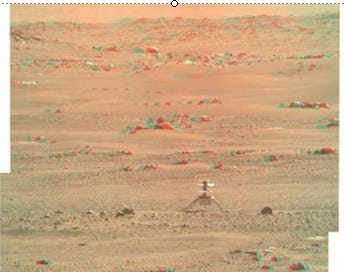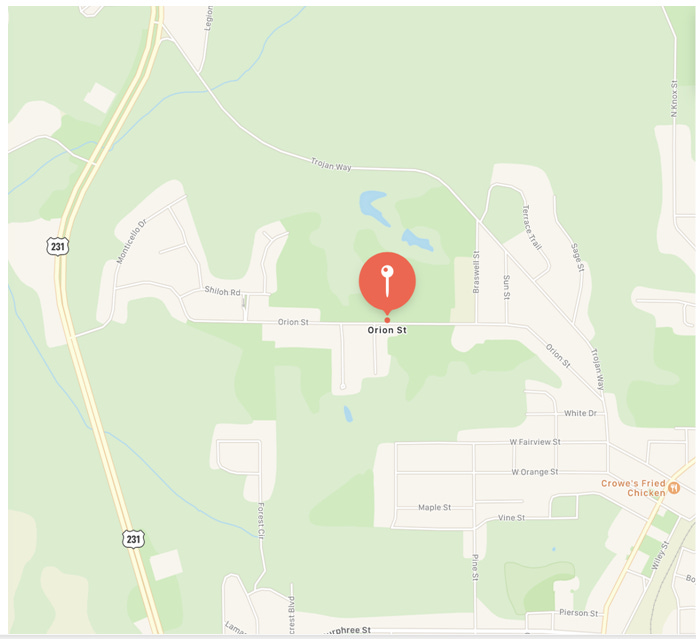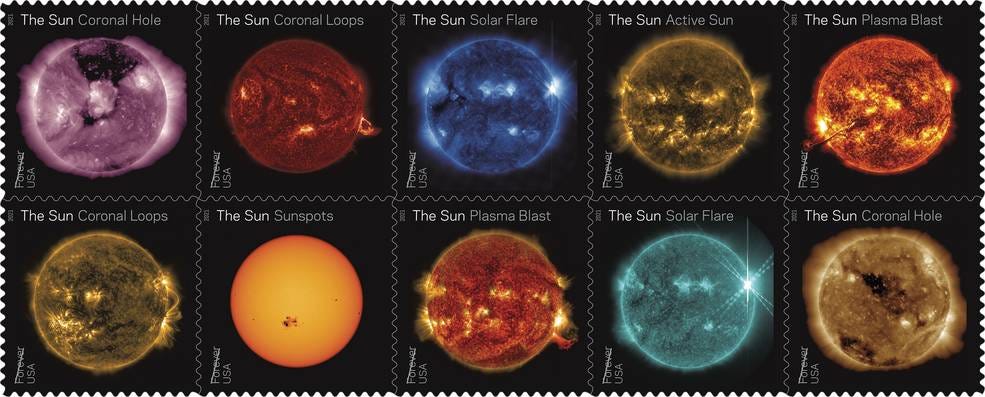The Galactic Times Newsletter #4 - July 1 - 15, 2021
Astronomy News, Sky Planning Calendar, Podcast, Astronomy in Everyday Life
Cover—Mars and Ingenuity in 3D!
Get out your Red and Blue glasses! Here's a "3-D" photo of Mars just released by NASA showing the surface near Perservence and showing the Ingenuity helicopter, which has completed 8 flights, more than it had been designed to make. Now it is following the Rover, and doing scouting missions for it.In This Issue:
This Just In — (formerly, Astronomy News)
Sky Planning Calendar
The Galactic Times Podcast - Harmony of the Spheres
The Classroom Astronomer Newsletter Highlights
Astronomy in Everyday Life - Solar Stamps, A Town Named Orion
Welcome to the fourth issue of The Galactic Times Newsletter! There is now an index to all issues, by issue number and by broad topic category, on the newsletter website, at www.thegalactictimes.com —yes, that is different from the newsletter mailing homepage on Substack, but an index or subsidiary pages are not permitted there.
If you are enjoying this twice-monthly newsletter, please support it by 1) using the link at the end to spread copies to your colleagues and friends and urge them to subscribe (why should you do all the emailing, right? We’re glad to do it!) and 2) buy us a lemonade —it’s hot in Alabama!— at our Patreon site. Thanks!
This Just In—Astronomy News
* Largest Comet Ever?
From a press release from the US NOIRlab—”A giant comet from the outskirts of our Solar System has been discovered in 6 years of data from the Dark Energy Survey (DES). Comet Bernardinelli-Bernstein is estimated to be about 1000 times more massive than a typical comet, making it arguably the largest comet discovered in modern times. It has an extremely elongated orbit, journeying inward from the distant Oort Cloud over millions of years. It is the most distant comet to be discovered on its incoming path, giving us years to watch it evolve as it approaches the Sun, though it's not predicted to become a naked-eye spectacle.”
The comet, an estimated 100–200 kilometers across, ~10 times the diameter of most comets, is an icy relic flung out of the Solar System by the migrating giant planets in the early history of the Solar System. Pedro Bernardinelli and Gary Bernstein, of the University of Pennsylvania, found the comet — with the designation C/2014 UN271 — hidden among data collected by the 570-megapixel Dark Energy Camera (DECam) mounted on theVictor M. Blanco 4-meter Telescope at Cerro Tololo Inter-American Observatory (CTIO) in Chile.
Its current inward journey began at a distance of over 40,000 astronomical units (au) from the Sun — in other words 40,000 times farther from the Sun than Earth is, or 6 trillion kilometers away (3.7 trillion miles or 0.6 light-years — 1/7 of the distance to the nearest star). For comparison, Pluto is 39 au from the Sun, on average. This means that Comet Bernardinelli-Bernstein originated in the Oort Cloud of objects, ejected during early history of the Solar System. It could be the largest member of the Oort Cloud ever detected, and it is the first comet on an incoming path to be detected so far away.
It was first seen by DES in 2014 at a distance of 29 au, roughly the distance of Neptune, and as of June 2021, it was 20 au, the distance of Uranus from the Sun and currently shines at magnitude 20. The comet's orbit is perpendicular to the plane of the Solar System and it will reach its closest point to the Sun (known as perihelion) in 2031, around 11 au away, a bit more than Saturn’s distance from the Sun. Despite the comet’s size, it is currently predicted that skywatchers will require a large amateur telescope to see it, even at its brightest.
* The Shape of the Milky Way Galaxy as seen outside it, from pulsars
An interesting talk at the European Astronomical Society, at newsletter deadline time by Dr. Ashley Chrimes or the Netherlands Radboud University. If we could see the Milky Way as we can see other spirals, and their radio emitting neutron stars of different types, what would we look like? Which types make the best matches to our spiral features?
Actually, Chrimes had two interesting results. First, he used various large datasets to build maps of the Milky Way. The tremendously large and accurate star data of Gaia, locations of Mira variables to build up the Milky Way’s bar (we ARE a barred spiral, in case you didn’t know that), catalogs of hydrogen emission nebulae and masers and other objects—-all to make a map of our half of the galaxy; data for the other half is not yet up to the same level of accuracy and completeness. That map is below.
Dr. A. Chrimes Milky Way Map, the Sun/Earth's position marked.Then, he mapped the various kinds of pulsars and neutron stars onto this Milky Way image. It turns out the Fast Radio Bursters, a kind of neutron star, are the best matches for spiral structure. This is presumably because they are younger neutron stars and haven’t yet strayed far from their spiral arms like other neutron stars. The next best map, as measured by him and known before, are Type Ia supernovae, a presumed source of neutron stars as well.
Sky Planning Calendar
Moon-Gazing
Moon passages by a star, planet or deep sky object are a good way to find a planet or other object if you’ve never located it before.
July 1 Last Quarter Moon.
July 7-8 Waning quite-thin crescent Moon is above Mercury the first of these mornings, to the left the second. Really the best chance to find the small world on this not-very-easy morning appearance.
July 9 New Moon.
July 11-12 The growing, 2-3-day old Moon makes a tight threesome with Mars and Venus in the evening sky, the Moon, below and right about 4 degrees the first night, above and left of them the second.
July 17 First Quarter Moon.
Observing---Plan-et….
Sun spends this fortnight in Gemini, despite the newspapers saying it is in Cancer.
Mercury is a very nice morning star but nice only if you are in the Southern Hemisphere. It is at its greatest distance (elongation) from the Sun on the 4th and near the Moon (and the star El Nath - sometimes Al Nath—the southern tip of Taurus the Bull’s two horns) the 7th and 8th—use binoculars for this conjunction.
Venus mimics Mars’ bulldozing through the Beehive starcluster M44 in Cancer (good thing the Sun isn’t actually in the constellation, eh?) on the 2nd and 3rd—use binoculars to have any chance in the twilight to watch this. Then, Venus and Mars meet up in the evening twilight, getting to within a full moon’s width—a half degree—apart on the 12th. Finding the two is helped on that day with the Moon above and left then, below and right the night before. is starting to hit its stride.
Earth is farthest from the Sun on July 5th, its aphelion, at 94, 510, 886 miles, or 152, 100,527 kilometers. Yet this is summer time in the northern hemisphere! Sure puts a lie to the conception that summer is caused by us being closer to the Sun, doesn’t it?
Mars is best viewed with that conjunction with Venus mentioned just above. Although Mars doesn’t reach conjunction behind the Sun until early October, this is essentially the last “easy” time to see the Red Planet.
On the 26th, Mars and Saturn are exactly 180 degrees apart on the sky, in opposition to each other. When Mars goes down, Saturn appears rising on the opposite side of the sky.
Jupiter, to the left of Saturn, rises at the end of evening twilight on July 13th. It is nearly prime time for this planet.
Saturn rises an hour before Jupiter does.
For the Future
By the beginning of September, we’ll have three first magnitude or brighter planets in the evening sky! Venus setting after twilight ends—until New Year’s, Saturn, at opposition August 1 and up all night after that, Jupiter rising like Saturn at sunset but it starts that August 22.
Summertime is here! Check if it is time for a glass of something cool to drink…with the Hermograph Wearable Sundial T-Shirt! Works as a clock or a compass.
The Galactic Times Podcast
Exoplanetary Music Part 1
Johannes Kepler believed the planets moved with heavenly tones. Some have even created music with them, in modern recordings. But now some have done the same with exoplanetary systems. Tune in to The Galactic Times Podcast, to hear how astronomer Dr. Frederic Hessman, of the University of Goettingen, Germany, has been the latest to convert Kepler’s book Harmonice Mundi—Harmony of the World (1619)—to music that approximates the planets’ orbital distances and eccentricities. He explains Kepler’s reasonings, and how musicians would make the chords and notes. All to be the background on how he then does this with exoplanetary systems, in Exoplanetary Music Part 2!
In addition, sky events will be discussed in the feature Skies Over Earth.
Hear on your favorite podcast service, including the first ever sounds of 55 Cancri’s system, and the Day of Judgement Star. You can also listen via your web browser on the Podcast webpage player on www.thegalactictimes.com .
Astronomy in Everyday Life
One might think that a town with dreams of grandeur might name itself after one of the grandest constellations of the sky. Orion AL, did just that. It is a mere hour and a half drive from Hermograph HQ. On a sunny Friday, I and my son took a field trip to find it in rural countryside Alabama.
It is an outlier town to Troy, a burg south of the state capital Montgomery, and home to an outsized Troy University that rather dominates the otherwise small city. Orion once was on the main route between Montgomery and Troy and onwards south to larger Dothan and Panama City, Florida. This route, US 231, has been turned into an interstate level, four-lane, divided highway and like those construction works often do, it has bypassed this more than two-centuries-old town and caused it to all but disappear.
Many streets even today derive their names from where they go; i.e. some Smithville Street might take you to Smithville. In Troy, starting on the northwest side of downtown is Orion Street. It no longer connects to the main north-south street, part of US 29 known locally as Three Notch Road; it misses it by one long block. Orion Street is about two miles long, simply residential now. Its western end is interrupted by a more modern enclave and a small woods, and a street renaming. There is one other astronomical intersecting street, Sun Street.
Branching off of Orion Street near its beginning is more expansive, run down, and somewhat commercial Trojan Way but, in about two miles, it actually connects to US 231. About three miles north, at Friendship, AL, one exits on the right onto a parallel local route. Marked on the highway as CR (County Road) 7714, it is also on various digital maps as Route 105, Old Highway 231, and Orion Drive, though none of those last three were evident during a drive on the road, by sign or by labels on mailboxes.
It is about six miles to the only visible remnants of Orion, Alabama, at the only significant crossroads along this original routing of 231. [Historical note—an even OLDER routing of 231 is frequently visible alongside this roadway, as a twisting and winding, slightly wider than single lane yellowing concrete pathway, closer to many existing and sometimes structures in ruins.]
Downtown Orion--a welcome sign, a barrior on OLD old US 231, a ruined wooden store front (with some real vultures on the roof). The Hunter would not feel very honored. Photo by the author.According to both Wikipedia and a sole historical marker, Orion was originally founded as Prospect Ridge (in 1813) and was incorporated with the constellation name in 1850. A wealthy plantation conclave, it lasted only 31 years. It once boasted a school of higher learning, which became a local school, the Orion Institute, which went away in 1929, outlasting its post office by 26 years. Nothing remains of the institute but a leveled hill-top. Today, there are only 24 residents.
Nearby are two churches that use the name Orion, and a cemetery, one known to have a Revolutionary War era African-American soldier buried in it.
Beyond this, there is just a Lockheed-Martin facility nearby, but it doesn’t use the city name.
Depending on your searching, there are a total of 6 to 9 Orions in the US, all but two are hamlets like this one. The exceptions are one in Illinois near the Quad Cities of Iowa, with a population of nearly 2000, and a township and village of nearly 40,000 in Michigan. Outside the US, there is a city that recently changed its name to Orion in the Philippines that is rather large, another in Brazil, and a few small villages with no real Web presence in a few European nations. Orion the Hunter would not be honored.
****
Sun Science Stamps Highlight a Decade of Sun-Watching from Space
To start off the summer, the U.S. Postal Service issued a set of stamps highlighting views of the Sun from NASA’s Solar Dynamics Observatory. Showcasing a range of solar activity seen by the spacecraft, the stamps celebrate a decade of Sun-watching for this workhorse mission. The Sun Science stamps were issued by the U.S. Postal Service during a ceremony at the Greenbelt Main Post Office in Maryland on June 18.
—————————————————————————————-
The Classroom Astronomer Newsletter Highlights
This premium newsletter will be for paid subscribers only, but if you click this link, for an introductory time, you can read this for free!
Cover Photo - How the Earth Tilts
Connections With The Sky
A Call to Join a Zooniverse Activity on CO2 effects on Mars, and Earth
IAU’s Official List of Astronomy’s Connections to Other Human EndeavorsAstronomical Teachniques
The Galactic Times Podcast on The Harmonies of the World—Useful for the Visually Impaired, and the Not Visually ImpairedRAP Sheet – Research Abstracts for Practitioners
* Motivations and Attitudes of Attendees at Public Science Event Observing Sessions
* Tell Me a Story, Professor! The use of historical stories in Physics (and AstronomyA Look at Next Generation Science Standards, in Astronomy. Part 1.
Coming Soon!
Learning Astronomy Under The Northern Stars – A 365-Night Per Year Textbook
Use the stars that are ALWAYS visible to understand basic astronomy, stellar evolution, galactic structure, with the naked eye and common binoculars. EBook and print book coming. Detail description and advance orders link coming soon.
Writing this in those hot and humid Alabama days requires lots of cold lemonade. If you like The Galactic Times Newsletter, buy us a glass at
If this is your first issue and you’d like to continue to receive issues,
Spread the word and get others to sign up!
Articles for The Galactic Times Newsletter are welcome. So are sponsorships and advertisements. Query us at Newsletter {at} TheGalacticTimes dot com .
Learn more about other products by the publisher, including books and educational materials in historical tourism and astronomy education, at http://www.hermograph.com.
This newsletter is (c) 2021 Hermograph Press LLC, Opelika, AL. All rights reserved. No part of this may be reproduced without permission in any other medium, such as newspaper columns, webpages, blogs, etc. Please contact the undersigned for permissions, etc. Please do not feed the hungry lawyers…….













